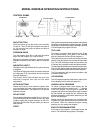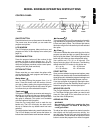29
ENGLISHENGLISH
ENGLISHENGLISH
ENGLISH
SOLUTIONS TO COMMON DISHWASHING PROBLEMS
As with any new appliance, it sometimes takes using it a few times to learn to operate it properly. If you are
having minor performance problems with your dishwasher, read this section before calling for service. It may
save you time and unnecessary expense.
Poor washing performance
← The dishes may not be loaded properly. Make sure that soiled surfaces are facing downward or toward
the center of the dishwasher. Also, make sure that the bowls, pots, etc., are not stacked so closely that
water can’t reach the soiled surfaces.
← Make sure you are using the appropriate program settings for the dirtiness of your dishes.
← An item may be obstructing the spray arm rotation. With the baskets loaded and in place, manually turn
the spray arms to make sure they move freely.
← Your dishwasher detergent should be fresh and stored tightly closed in a cool, dry place. Old or caked
detergent will not dissolve properly. Wait until you are ready to start the dishwasher to add the detergent.
If you are using the Delay program, make sure the dispenser is dry before adding the detergent.
← Your dishwasher detergent may be inferior. Try a different brand.
← Make sure the rinse aid dispenser is filled. (See page 20.)
← If you have hard water in your area, try adding more detergent and increasing the amount of rinse aid
dispensed. (See page 20.)
← Check that the spray arm jets are not clogged. (See page 27.)
Poor drying performance
← Select the Fan Dry option, if available.
← If you don’t want to use Heat Dry, you can decrease the drying time by opening the door slightly to let out
the warm, humid air.
← Make sure the rinse aid dispenser is filled. (See page 20.)
← Make sure you use the proper amount of rinse aid. (See page 20.)
← Do not overload the dishes and be careful to avoid nesting.
← Load items with concave bottoms tilted so as much water as possible will run off.
← Unload the bottom basket first to avoid spilling water onto the dishes when unloading the top basket.
← Dishes washed in higher water temperatures will dry faster.
← Certain plastics may need to be towel dried.
Plastic items
← Always check the manufacturer’s suggested care instructions before washing plastic in your dishwasher.
Even dishwasher-safe items should be loaded in the top basket, away from the heating element.
← Some high-acid foods can discolor plastic. You should rinse these items if you do not plan to run the
dishwasher right away.
← Plastic items dry poorly and may need to be towel dried.
Chipped or broken dishes
← When you load the dishes, be sure they’re securely in place and will not fall over or strike against each
other during the wash.
← Load glasses between the tines, not straddling them.
← Move the baskets in and out slowly to avoid slamming the dishes together.
← Make sure not to load dishes so high that the spray arms could strike them.
← Make sure tall glasses and stemware will clear the top of the tub when you push the basket in.
← Always load delicate items in the top basket.
← Do not overload the dishwasher.
← Do not jam the glasses together when loading.
Stains and discolorations
Stains or discoloration on dishes could be caused by a number of things. Listed below are some of the most
common causes. See also “Washing Special Items” on page 32.
← Too much iron or manganese in the water can cause yellow or brown marks on your dishes. As a temporary
solution, in place of the prewash detergent, use one teaspoon to one tablespoon of citric acid crystals.
You should consider installing a water filtering system.
← Coffee and tea stains usually have to be removed by handwashing in a solution of 1/2 cup bleach and
one quart of water. (Do not use on sterling silver or silver plate.) Be sure to rinse these items thoroughly
before putting them in the dishwasher so there is no bleach residue on the dishware.


















